Build a "zero defect" LED giant screen in 30 days

I. Project Overview
1. Goal: Build a high-performance, high-stability display system to meet the needs of scenarios such as advertising, conference demonstrations, and real-time data monitoring.
2. Scope: Covering the entire chain of screen production, steel structure construction, control system integration, and operation and maintenance.
3. Core functions
⑴ Basic functions: 4K/8K ultra-high-definition display, multi-signal access (HDMI/SDI/network);
⑵ Intelligent expansion: adaptive brightness adjustment, remote fault diagnosis, and emergency broadcast control.
II. Construction preparation
1. Technical preparation
⑴ Drawing review: The joint design party reviews the matching of the screen layout and the load-bearing structure, and corrects the pipeline conflict (if the strong and weak current spacing is less than 30cm, it needs to be adjusted).
⑵ Technical disclosure: The technical director explains the installation process and lightning protection grounding standards (grounding resistance ≤4Ω).
⑶ Construction organization design: Prepare a progress network diagram, safety plan, environmental protection measures, and clarify key processes such as welding parameters.

2. Personnel preparation
⑴ Team formation
① Project general dispatch (coordination of resources)
② Project manager (progress/quality control)
③ Technical team (electrical/structural engineer)
④ Safety officer (full inspection)
⑵ Training content
① Skills: box splicing flatness control (error ≤ 0.5mm), optical fiber fusion technology;
② Safety: high-altitude operation protection, TN-S power distribution system operation specifications.
⑶Material preparation

III. Construction schedule
1. 30-day schedule
Phase Time Key tasks
Foundation construction Day 1-7 Steel structure welding, lightning protection grounding network laying
Screen installation Day 8-18 Box splicing (from bottom to top), optical fiber wiring
System debugging Day 19-25 Color correction, multi-window segmentation test
Acceptance and delivery Day 26-30 72-hour aging test, user training
2. Progress guarantee measures
① Plan decomposition: daily morning meeting deployment tasks (such as "complete 50% of the box installation on the east side on the 10th day");
② Resource guarantee: reserve 10% spare modules in advance, and hoisting equipment is on standby 24 hours a day;
③ Communication mechanism: weekly tripartite meetings (owner/construction/supervision), problems are closed within 24 hours.
IV. Construction methods and technical measures
1. Steel structure frame construction
① Material processing: laser cutting (error ±1mm), CO₂ protection welding, sandblasting rust removal + epoxy zinc-rich paint anti-corrosion.
②Precision control: The total station calibrates the verticality of the column (deviation ≤2mm/㎡), and the level ensures the horizontality of the beam (error ≤3mm).
2. Display installation
① Cabinet splicing: Install in the order of "center to surrounding", and the caliper controls the joint seam ≤0.1mm; the aviation plug tension test ≥50N.
②Line identification: strong wire (yellow/green/red phase separation), weak wire (blue label), optical fiber (orange sheath), wear metal shielding tube.
3. Control system debugging
⑴Hardware installation: The distance between the sending card and the receiving card is ≤80m, and the splicing cabinet reserves heat dissipation space (≥10cm).
⑵Software debugging:
①Resolution matching: point-to-point mapping of input source and physical pixel;
②Color correction: CA-410 colorimeter is calibrated point by point to ΔE≤1.5 (color difference is indistinguishable to human eyes).








